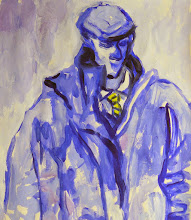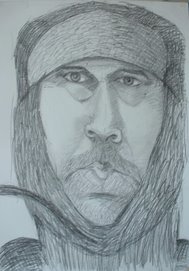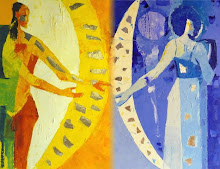Yesterday at the
Buddhist Centre in Glasgow I heard a short poem by Walt Whitman called 'Song of the Open Road' from a little book called 'Reflections on Wildness' This appealed to me so much I bought a copy from the bookshop. It had been reduced to less than half-price appealing to me even more! I will probably have to think on that poem further before anything can come of it but what did make an instant visual impression on me was a story in that same volume about the
Dakini, or Sky Dancer. The word '
dakini' comes from the Sanskrit root meaning direction, space or sky and symbolises the
transformative energy of the transcendental in female form. The sky symbolises the open dimension of being, an infinite space in which there is complete freedom of movement. The
dakini dances in this open space, enjoying complete spiritual freedom and her body is naked, symbolising her uncompromising
commitment to truth. She is usually depicted with the colour red, and she has wild,
unruly, black hair. No wonder I was taken by her and thought that I must try my hand at painting this fantastic and beautiful woman. The first painting, below, is the culmination of a hard days work although this still is just what I would call a 'colour study' with an oil painting to follow:
 Felt pens and watercolour on paper, A4
Felt pens and watercolour on paper, A4: The various development stages are shown below each in turn leading to this loose watercolour image. What started out as broad sweeps of the pastels ended with this more definitive and less stylised depiction of the lady herself dancing a "Red-hot Salsa" in the sky, with her male counterpart following her lead. He is shown green as the
complementary to the female red and he is also rooted in the earth as shown by the flowers around
Dakini's feet. It is a night sky with silver stars and a blood-red crescent moon with a multi-coloured "aurora
borealis" playing around her legs. The male figure has shifted to this left side position from the previous studies in order to achieve greater interaction with his object of adoration. Some of the development studies are shown below:
 Pastel on paper, A2: Development Study 1: The sinuous curve of the female form is created in one bold stroke. Looks snake-like to me but I am possibly carrying these symbolics too far!
Pastel on paper, A2: Development Study 1: The sinuous curve of the female form is created in one bold stroke. Looks snake-like to me but I am possibly carrying these symbolics too far!
 Pastel on paper, A2: Development Study 2: The dancing female form begins to appear.
Pastel on paper, A2: Development Study 2: The dancing female form begins to appear.
 Pastel on paper, A2: Development Study 3: I've added her black, unruly, hair, and a crescent moon to indicate the night sky, and the beginnings of an adoring male figure (bottom right) in green.
Pastel on paper, A2: Development Study 3: I've added her black, unruly, hair, and a crescent moon to indicate the night sky, and the beginnings of an adoring male figure (bottom right) in green.
 Pastel on paper, A2: Development Study 4: I have taken the stylisation to a point where I am not sure whether I want the painting to be like this. I have added multi-colours to indicate the Aurora Borealis and I've made the moon blood-red for further dramatic effect. I like it but somehow it's becoming something I am not so sure of. So using the symbolic elements I have already developed I return to more representational figures as seen in the first painting in watercolours.
Pastel on paper, A2: Development Study 4: I have taken the stylisation to a point where I am not sure whether I want the painting to be like this. I have added multi-colours to indicate the Aurora Borealis and I've made the moon blood-red for further dramatic effect. I like it but somehow it's becoming something I am not so sure of. So using the symbolic elements I have already developed I return to more representational figures as seen in the first painting in watercolours.
 Felt pens and watercolour on paper, A4: The various development stages are shown below each in turn leading to this loose watercolour image. What started out as broad sweeps of the pastels ended with this more definitive and less stylised depiction of the lady herself dancing a "Red-hot Salsa" in the sky, with her male counterpart following her lead. He is shown green as the complementary to the female red and he is also rooted in the earth as shown by the flowers around Dakini's feet. It is a night sky with silver stars and a blood-red crescent moon with a multi-coloured "aurora borealis" playing around her legs. The male figure has shifted to this left side position from the previous studies in order to achieve greater interaction with his object of adoration. Some of the development studies are shown below:
Felt pens and watercolour on paper, A4: The various development stages are shown below each in turn leading to this loose watercolour image. What started out as broad sweeps of the pastels ended with this more definitive and less stylised depiction of the lady herself dancing a "Red-hot Salsa" in the sky, with her male counterpart following her lead. He is shown green as the complementary to the female red and he is also rooted in the earth as shown by the flowers around Dakini's feet. It is a night sky with silver stars and a blood-red crescent moon with a multi-coloured "aurora borealis" playing around her legs. The male figure has shifted to this left side position from the previous studies in order to achieve greater interaction with his object of adoration. Some of the development studies are shown below:








2 comments:
She is absolutely amazing. The color, the gesture, everything. The process shots are wonderful too. I am Buddhist, but was not aware of this personage--now I am, thank you!
I only hope, Kathryn, when I do the oil painting that I can maintain the freedom of the watercolour. I'm glad you like her. She's my kind of gal!
Post a Comment